After suffering two straight losses at the start of their 2020/21 Ligue 1 campaign, PSG managed to earn their second straight league win this past weekend as they cruised to a 3-0 win over OGC Nice at the Allianz Riviera.
Meanwhile, in contrast to Les Parisiens, this past weekend’s game condemned Nice to a second straight Ligue 1 defeat, after they got off to a perfect start in their opening two games of the season, meaning that these two teams are now level on six points each four games into the 2020/21 campaign.
In this tactical analysis piece, we will look at the tactics behind Thomas Tuchel’s side’s dominant victory away to Patrick Vieira’s Nice. We will provide some analysis of both of these teams in and out of possession and we will attempt to determine what the key aspects to this game were for both teams from a tactical perspective.
Lineups and formations
Firstly, we will take a look at how both of these two teams lined up in this past Sunday’s Ligue 1 fixture. Starting with the home side, Vieira’s team lined up in a 4-3-3 shape for this clash with Les Parisiens.
Walter Benítez started between the sticks for Les Aiglons here, while a back four consisting of right-back Youcef Atal, left-back Jordon Lotomba and the central defensive pairing of left centre-back Dante and right centre-back Andy Pelmard played directly in front of him.
Morgan Schneiderlin started this game at the base of Les Aiglons’ midfield, while Pierre Lees-Melou and Khéphren Thuram played either side of him in slightly more advanced central midfield roles.
Hassane Kamara played at left-wing in this game, while Rony Lopes played on the right-wing and Amine Gouiri started this game in the centre forward position for Nice.
As for the away side, Tuchel lined his team up in a 4-2-4 shape for this one.
Keylor Navas started in goal for Les Parisiens in this one, while right-back Alessandro Florenzi, who is on loan with Paris from Serie A side AS Roma, left-back Mitchel Bakker and the central defensive duo of right centre-back Marquinhos and left centre-back Presnel Kimpembe made up PSG’s back four for this one.
Marco Verratti and Idrissa Gueye were PSG’s two starting central midfielders, while the PSG attackers were a quartet of Julian Draxler, Kylian Mbappé, Ángel Di María and Mauro Icardi.
PSG in possession
Moving onto the tactical analysis portion of this piece, firstly, we are going to look at PSG’s tactics in possession of the ball during Sunday’s clash with Nice.
The away side utilised the wings quite heavily in this game and as a result, their full-backs were integral to their tactics when in possession of the ball. Left-back Bakker, in particular, played quite a significant role for his side in the build-up and in terms of actual chance creation.
Bakker played 55 passes in this game, while PSG’s right-back, Florenzi, played just 29 passes, with both players remaining on the pitch for the full 90 minutes. This gives us an indication of just how involved the 20-year-old Dutchman was for his side last Sunday.
The heavy focus of PSG attacks on the left side of the pitch may also have had something to do with the fact that Mbappé was usually situated towards the left side of the pitch, either in a left-sided channel whilst occupying the centre forward position, or actually on the left-wing.
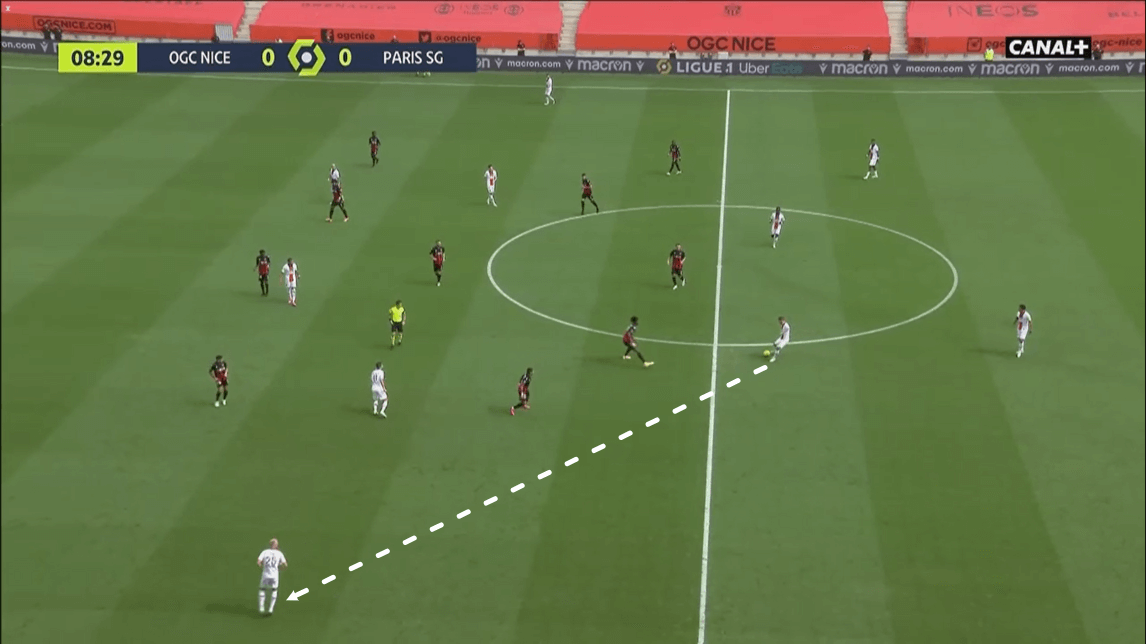
In this image above, we can see how PSG liked to create overloads on the left-wing by stretching the play via a pass from either the centre-back or central midfielder, in this case Verratti, out to the overlapping Bakker.
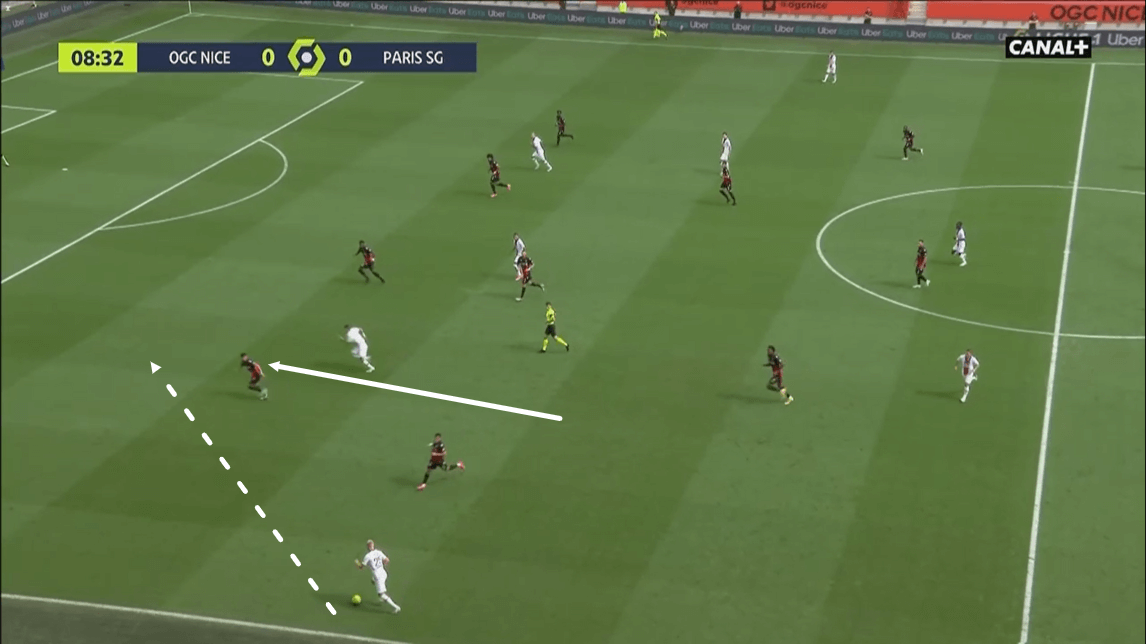
As Bakker received the ball, Nice’s defence would shift further to the left side of the pitch and as they did so, the nearest member of PSG’s front four, including Draxler who would often push up into the attack when Paris were in possession, would often burst forward making a run into the channel between the right-back and the right centre-back, as we can see here.
Bakker would then try to find this player via a through ball from the wing, into the centre. We saw PSG try this particular combination on a variety of occasions in this game and Bakker often played this particular role during the game, where he would make an overlapping run, but not continue to burst forward too far, instead acting as a wide connector between the defence and the attack, who PSG used to essentially play the ball around Nice’s narrow and compact defensive block.
This limited his movement to an extent, at times, however, this also allowed him to utilise his vision and passing ability to a greater extent.
PSG’s attackers enjoy quite a lot of freedom of movement in the opposition half of the pitch and one attacker would, at times, position themselves in a position like this, where they essentially hugged the touchline. This prevented Bakker from playing as he did in the previous passage of play that we looked at above.
However, on occasions like this, Bakker himself made the offensive run after playing the ball forward to this wide man, who would usually pose enough of a threat to attract the opposition full-back’s press, as we can see here, creating a fairly large gap between this full-back and the nearest centre-back.
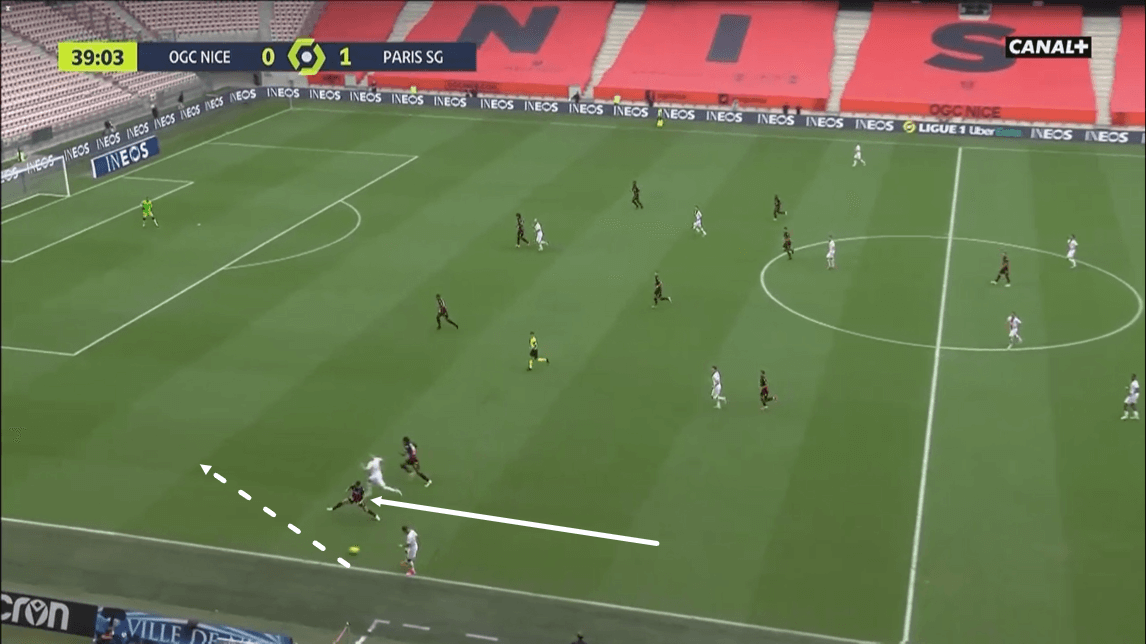
As play moves on, we can see that this PSG wide man simply held onto the ball, attracting pressure from the full-back and creating space for Bakker to then run into and get onto the end of this diagonal through ball from the wide area, directed centrally and into the final third.
So, as we can see, Bakker did also have an opportunity to show off his pace and movement against Nice, as he was the recipient of this diagonal through ball at times, however, what is clear is that this particular pass was a key part of Paris’ game last Sunday, with Les Parisiens putting together this kind of offensive move in a few different ways, all of which caused trouble for Vieira’s side.
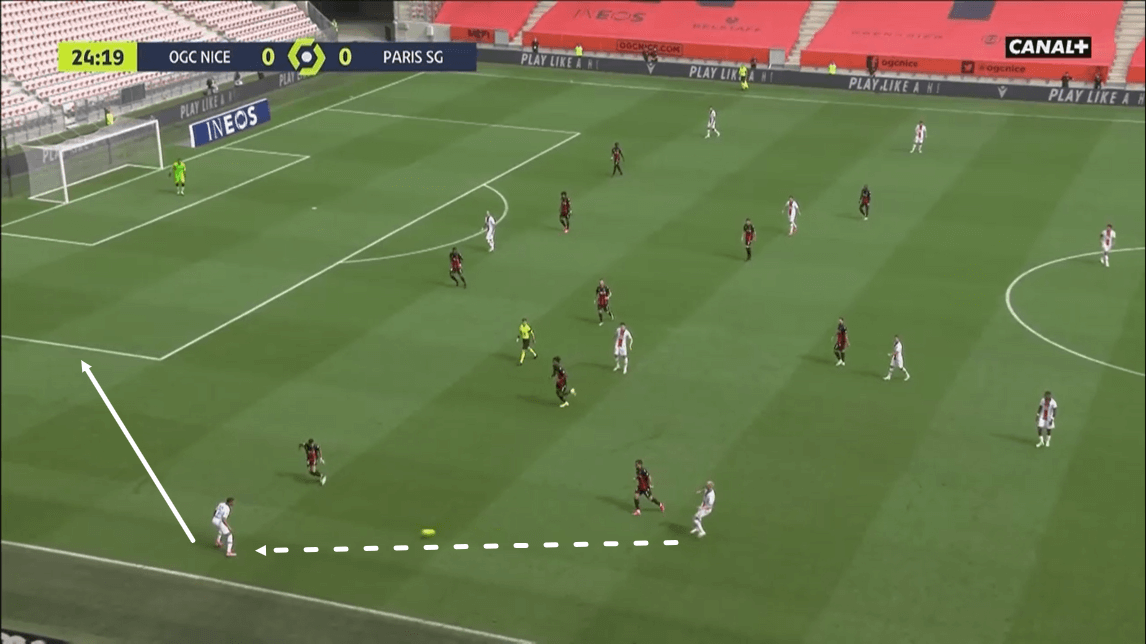
PSG also created problems for Nice via the wings in a more simple way, simply by positioning Mbappé out there at times and finding him out wide with a pass from the defence or from the midfield.
Here, we can see Bakker playing the ball out to Mbappé, who immediately attracts pressure from the right-back, however, due to Nice’s narrow and compact defensive shape, this leads to Mbappé being one-on-one with Atal and as one of the world’s best dribblers, it’s safe to say that this is a scenario that both PSG and Mbappé were comfortable with creating.
As this particular passage of play moves on, Mbappé receives the ball, performs some stepovers and swiftly moves past the right-back, continuing this attack by carrying the ball towards the box along the left-wing. Two of PSG’s three goals came via Mbappé runs from this type of position, indicating just how deadly he can be when isolated against a defender out wide.
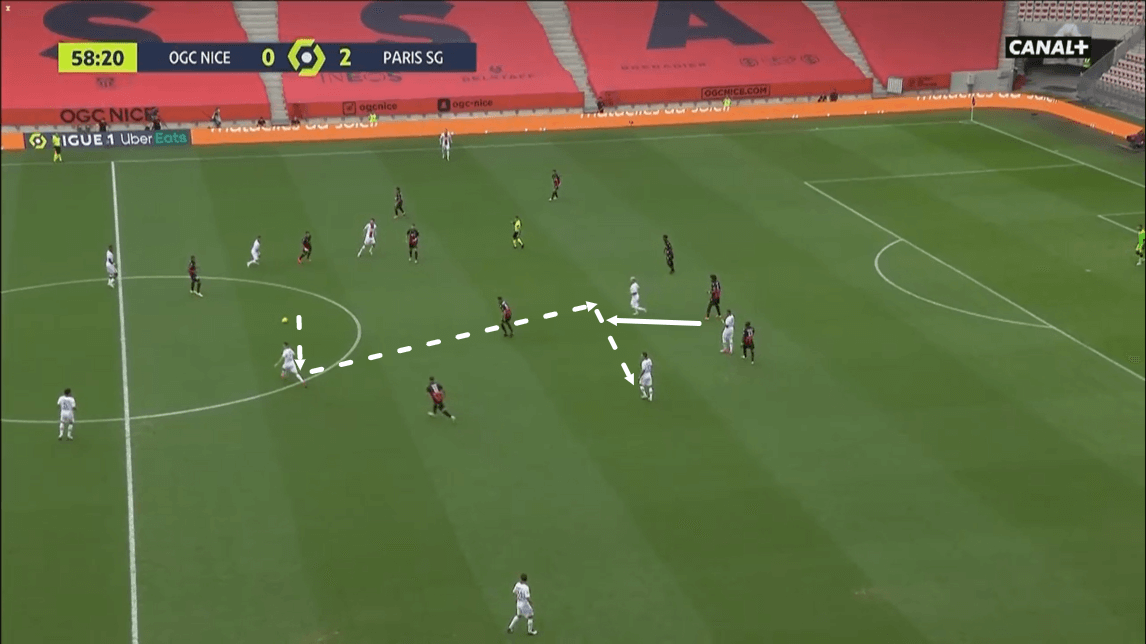
Aside from the wide areas, the off the ball movement of centre forward Icardi during periods of possession played quite an important role for Paris in this game at times. We can see an example of Icardi drifting into a pocket of space between the Nice backline and the Nice midfield line in the image above, and as play moves on, he ends up receiving the ball and connecting the midfield with the attack as he quickly releases and sets his side off on a dangerous attack.
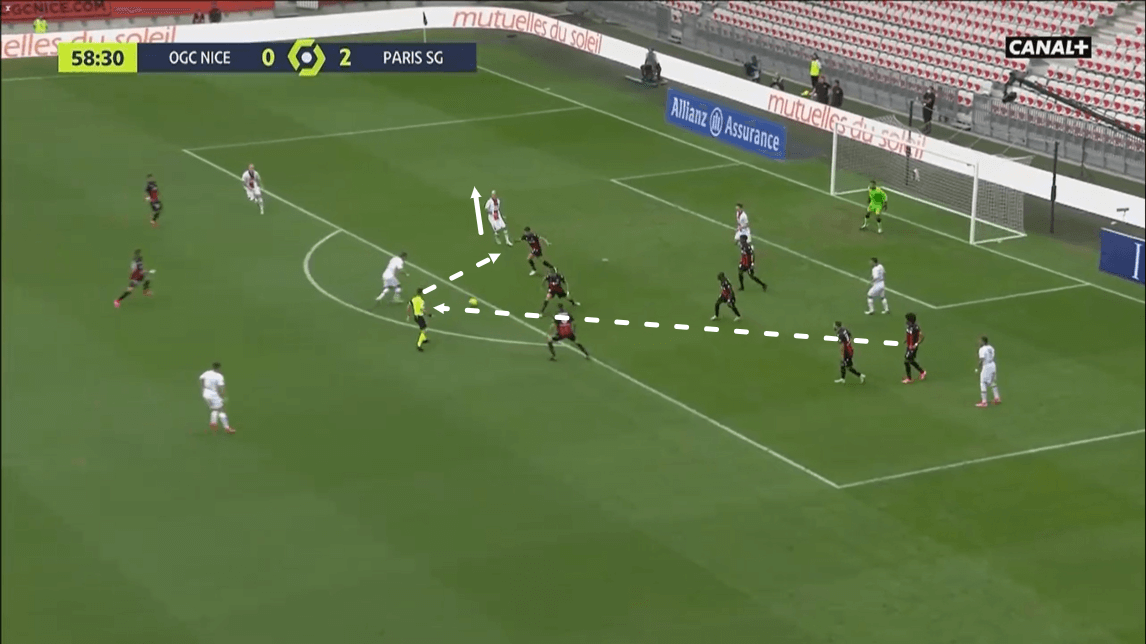
Icardi’s movement inside of the final third was important during the build-up, however, it was also extremely important in terms of finishing attacks. In the image above, we can see PSG in possession of the ball just on the edge of the box and as a defender goes to close this player down, we can see Icardi just peeling away off the back of that player’s shoulder and drifting into space. He ultimately pulls away and receives the ball here, forcing a save from Benítez.
This type of area is where Icardi is at his best, he doesn’t need to be heavily involved in getting the ball to the penalty area, but instead, he thrives off the ball, lurking around the box and looking for space in which he could potentially pounce on a loose ball in and around the goalmouth, as he did here.
PSG out of possession
PSG typically pressed more aggressively than Nice in last Sunday’s game. Their PPDA was 21.3, while Nice’s PPDA was 33.5, indicating that Les Parisiens allowed Nice to play fewer passes inside of their own final 60% of the pitch than Nice allowed PSG to.
Additionally, PSG made 0.27 recoveries per minute while Nice made 0.18 recoveries per minute in Sunday’s fixture.
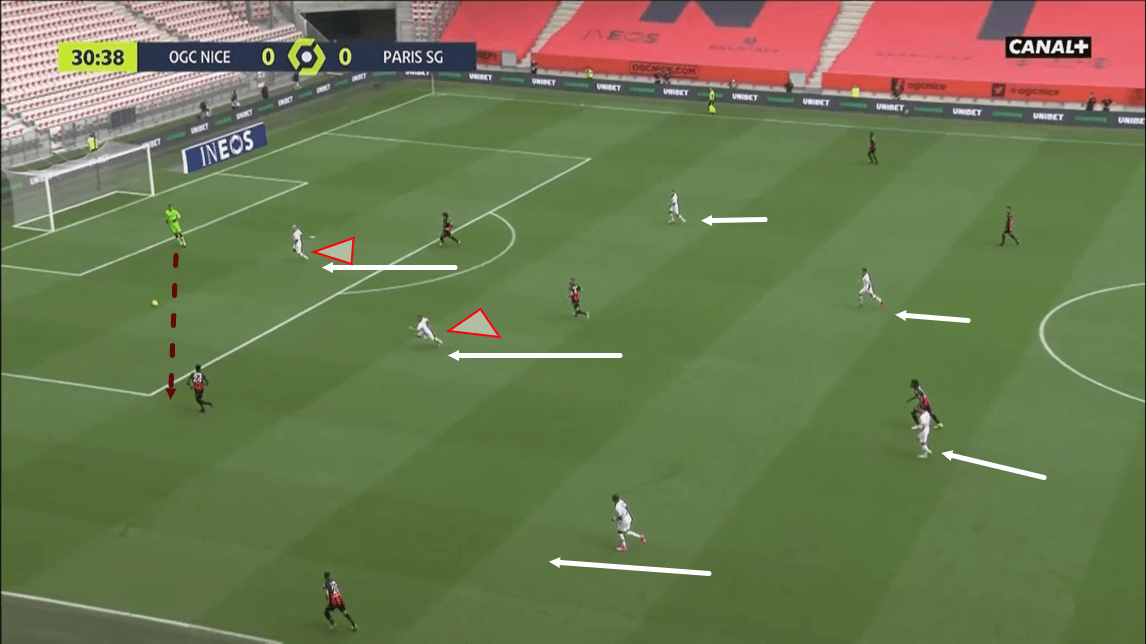
Tuchel’s side pressed Nice aggressively but in an organised and calculated manner during the build-up, as we can see in the image above. Just prior to this image being taken, Paris forced Nice to play the ball all the way back to Benítez. As the goalkeeper receives the ball, PSG continue to press with one player pressing the ‘keeper while keeping Dante in his cover shadow and another pressing quite high while keeping the nearest Nice midfielder in his cover shadow, thus leaving the right centre-back, Pelmard, as the only real viable short passing option at this particular moment.
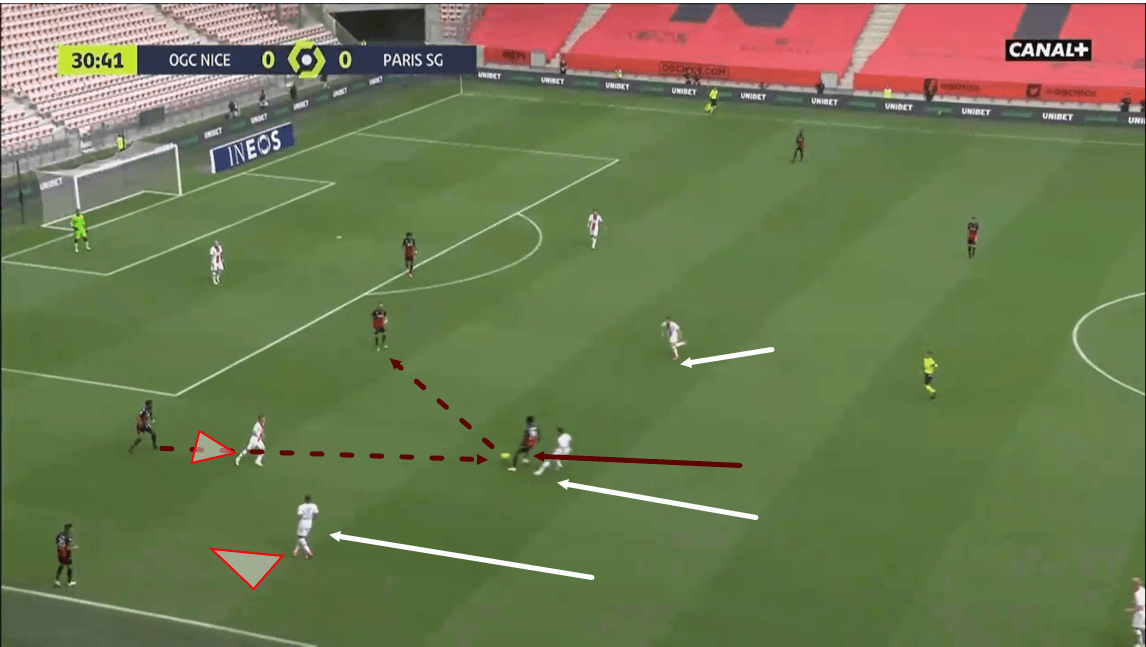
Then, as Pelmard receives the ball, Thuram drops from the right central midfield position to offer him a progressive passing option which he duly takes, however, Thuram is being tightly marked by one Paris midfielder who tracked his run and who prevents him from turning upon receiving possession. One PSG player marks the passing lane between Thuram and Pelmard, while another PSG player presses Thuram from the opposite side, leaving only the pass back to holding midfielder Schneiderlin open now.
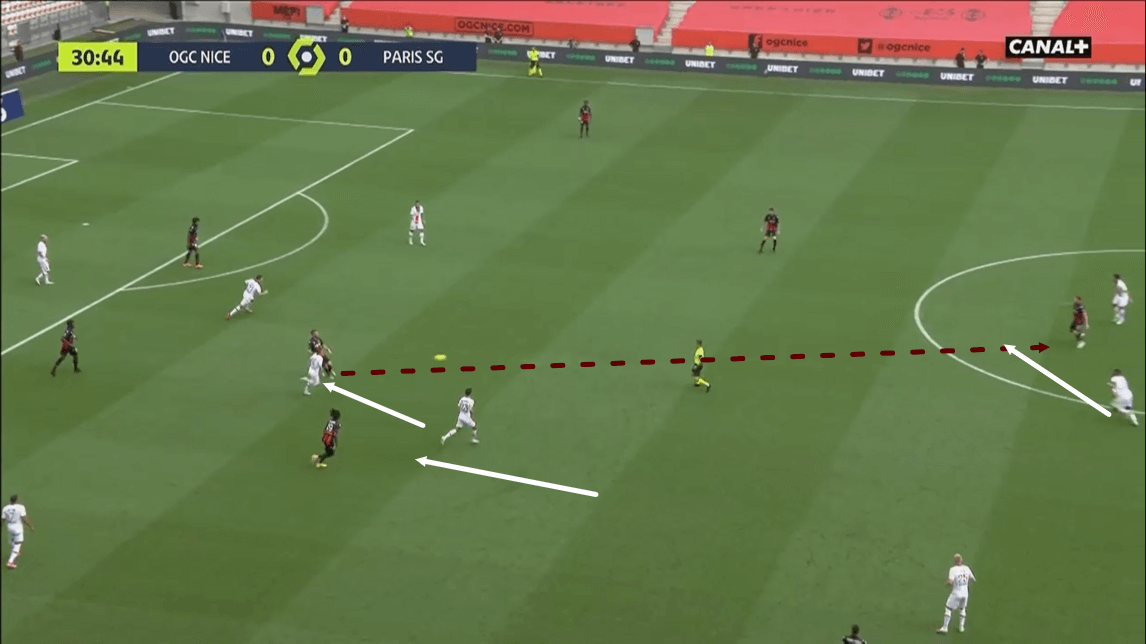
As Schneiderlin receives the ball in the centre, he then attracts pressure from the PSG player who had been pressing Thuram from the centre and with a progressive pass to Gouiri seemingly open, the former Everton man opted for that pass, however, this pass was being watched by one PSG player who darts forward from the defensive line to intercept this pass.
This passage of play provides us with an example of how PSG typically organised their press versus Nice on Sunday. They pressed Vieira’s side aggressively, but in a controlled manner, leading them to certain passing options, usually central options, before eventually pressing them into playing a riskier pass which Les Parisiens were then prepared to intercept.
Additionally, this passage of play shows us an example of how much freedom PSG’s defenders enjoyed to push out from the backline and intercept passes if need be and this was particularly useful in this game due to Gouiri’s movement, with the former Lyon attacker frequently dropping from the centre forward position into a slightly more withdrawn role.
This was frequently rendered ineffective due to the pace and intelligent reading of the game of the likes of Kimpembe and Marquinhos.
Nice in possession
Moving onto the home side, Nice played quite a patient, short-passing-focused style of football in Sunday’s clash with PSG. They ended the game with 53% of the possession.
Nice also took just two fewer shots (11) than PSG took (13) on Sunday, however, despite this, they ended the game with an xG of just 0.68 while PSG ended this fixture with an xG of 3.44.
This is partially because despite keeping more of the ball and taking only slightly fewer shots, Nice struggled to create clear-cut opportunities in this game, with Les Aiglons having an average shot distance of 22.5m to PSG’s average shot distance of 12.1m.
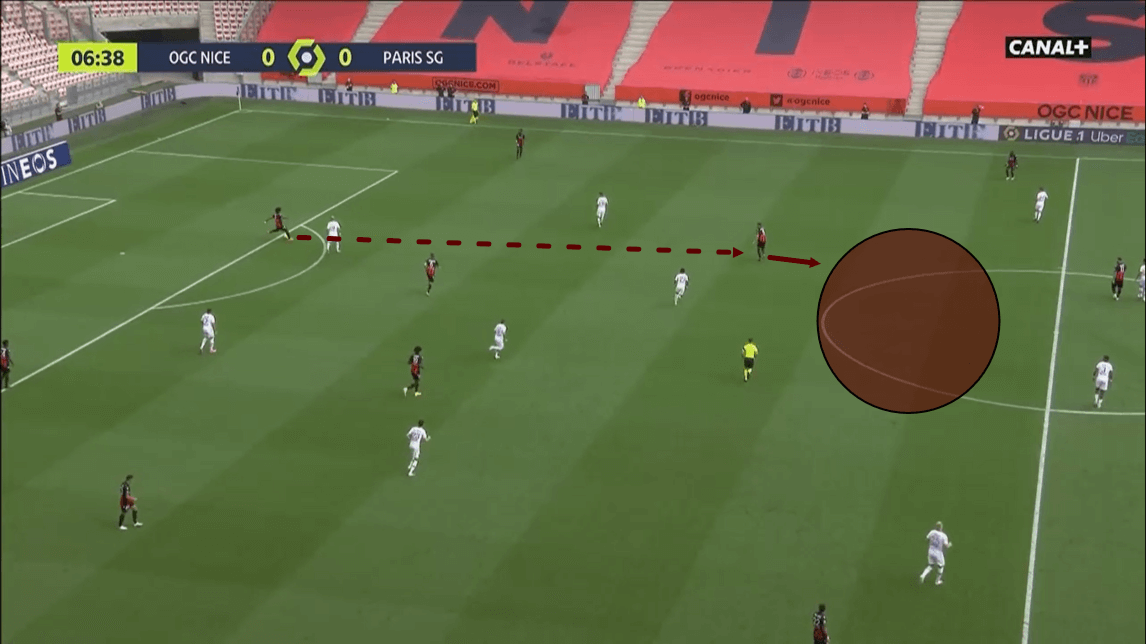
Looking at Nice’s tactics in the build-up, the home side tended to play the ball out short from the back as much as possible. They ended this game having played just 33 long passes, with PSG having played 44 long passes in the match.
While PSG pressed Nice high, this allowed Nice to draw PSG players further up the pitch, thus creating space higher up the pitch for more advanced Nice players to exploit, as we can see in the image above.
Here, we can see PSG utilising a 4-4-2 shape off the ball and we can see that while their press evidently limits the short passing options for Nice in the build-up, this creates a large amount of space between the backline and the midfield line.
Left centre-back Dante played a crucial role in helping Nice to exploit these gaps in Sunday’s game, as his ability on the ball was integral to helping Vieira’s side to play past multiple lines of pressure with just one pass, as he did here and on a number of other occasions. Dante was also a cool head in the Nice backline and was capable of playing the ball out despite being put under immense pressure by PSG’s forwards.
As this midfielder received the ball in this position, he subsequently turned and carried the ball forward for his side, allowing Nice to quickly break into the opposition half and create an attack, highlighting how important Dante’s skill-set was for Nice in the build-up.
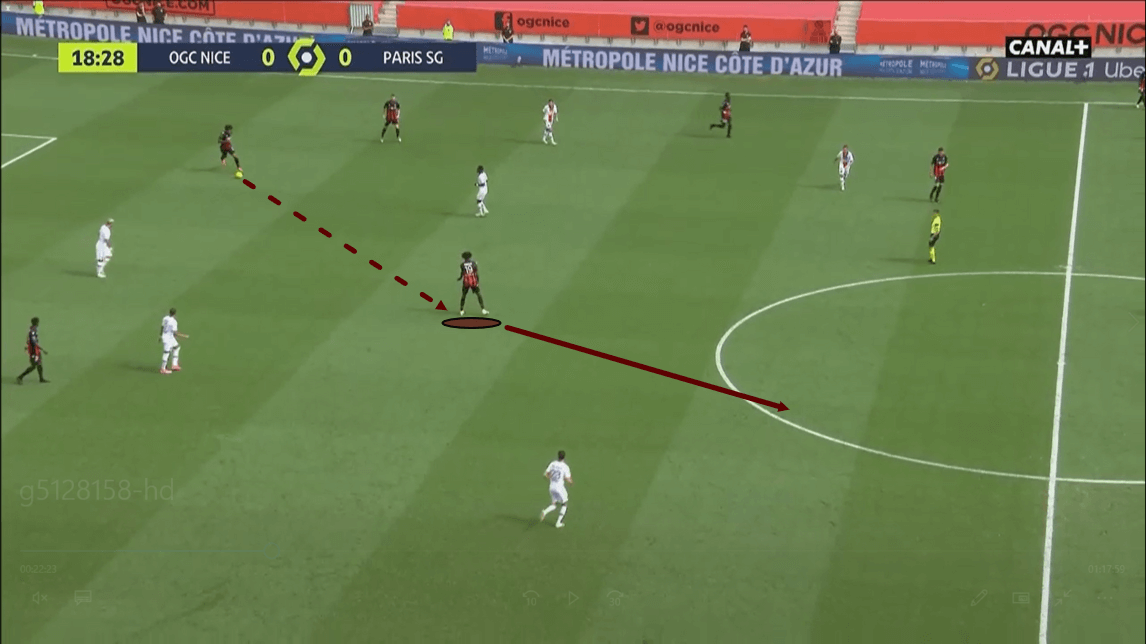
Additionally, at times, PSG’s pressing could leave space open right in the centre of the pitch for Nice to exploit in the build-up, which they did, as we can see here in this image above.
Here, space opened up in the centre of the park due to PSG’s pressing and Thuram then shifted into this space, making himself available to receive the ball.
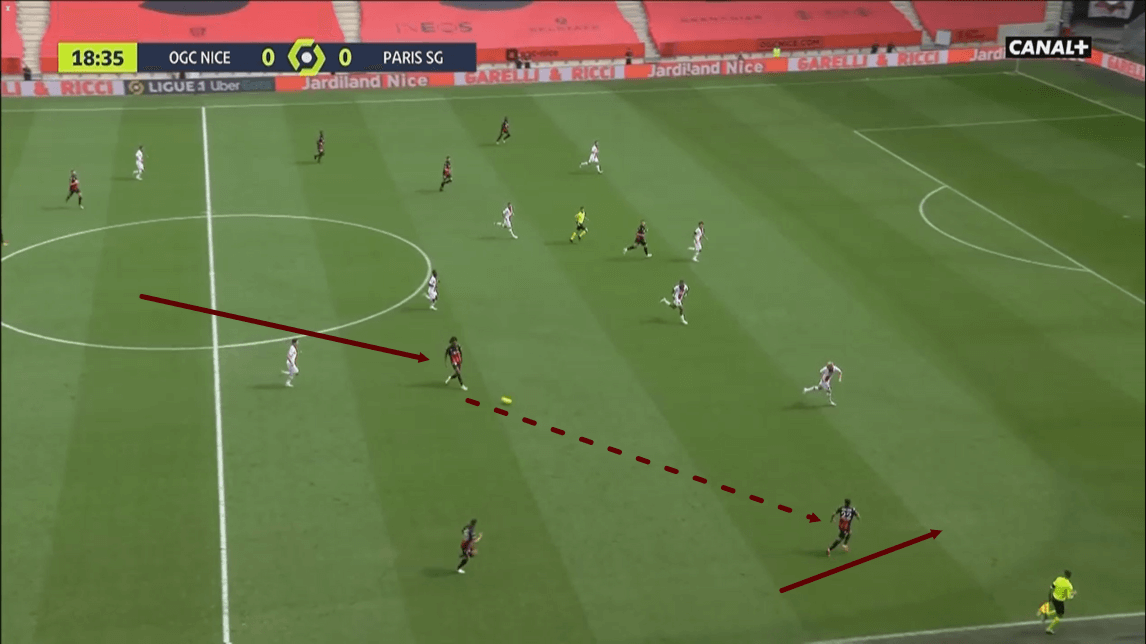
Dante quickly picked him out with a pass into the centre and though the midfielder attracted some pressure, his ball-carrying ability was good enough to beat the challenges and allow him to take the ball into the opposition’s half of the pitch.
Throughout this game, Nice’s midfielders had to utilise their ball-carrying ability during the build-up, as they were often able to find space in the middle of the park quite early on during an attack and rather than long-passes, this ball-carrying ability from the midfield helped them to break into PSG’s half of the pitch and progress the ball on into the final third.
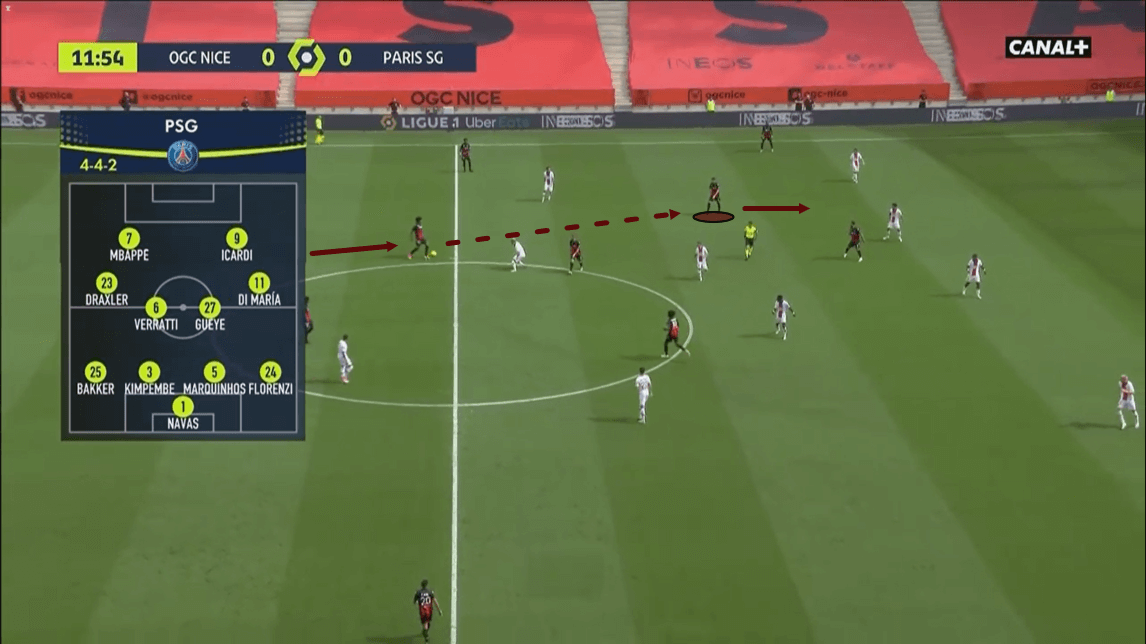
In addition to that, during slightly more advanced stages of the build-up, Thuram and Lees-Melou would often receive the ball in this type of position that we can see Lees-Melou occupying in the image above.
This position was behind PSG’s forward line, beside PSG’s midfield duo and in front of the PSG backline and this made them difficult to mark, evidently, as we can see him essentially drifting into this space to receive the ball unmarked.
As the midfielder receives the ball here, he turns and carries it forward, however, despite the effectiveness of the attack up until reaching the final third, Nice lacked penetration in the final third and failed to break down Tuchel’s side’s defensive line.
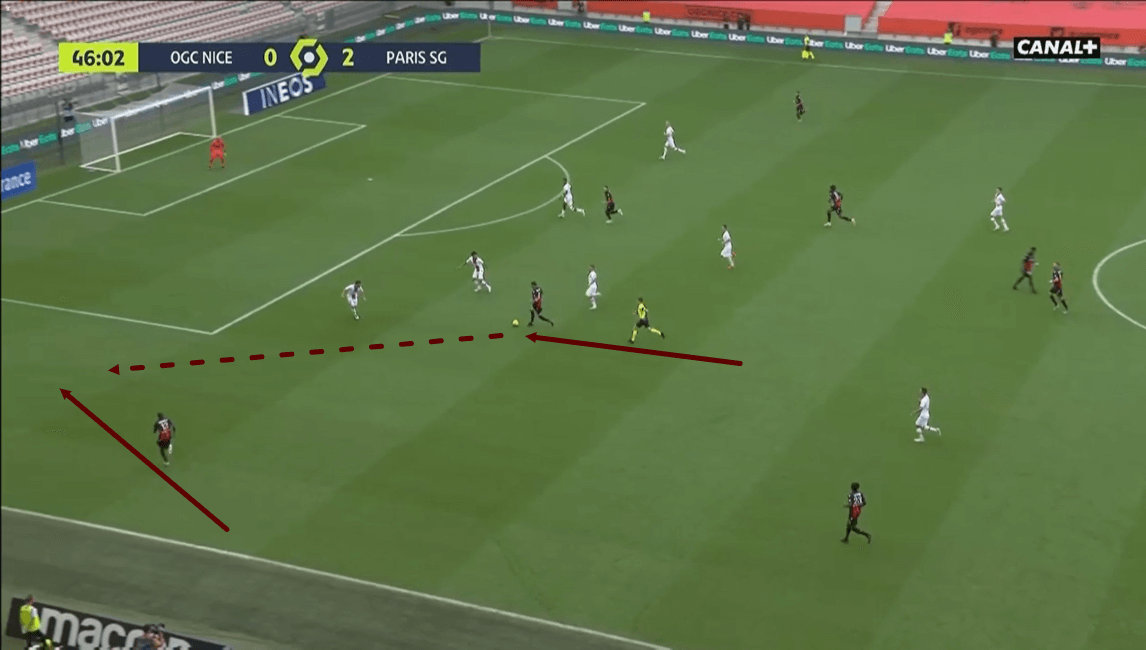
In addition to the midfielders carrying the ball forward themselves from these positions in the half-space during the build-up, they also, at times, combined with the wingers from these positions to create a 2v1 situation out wide and from here, left-winger Kamara subsequently receives the ball, carries it forward and drills an inviting low-cross into the penalty area.
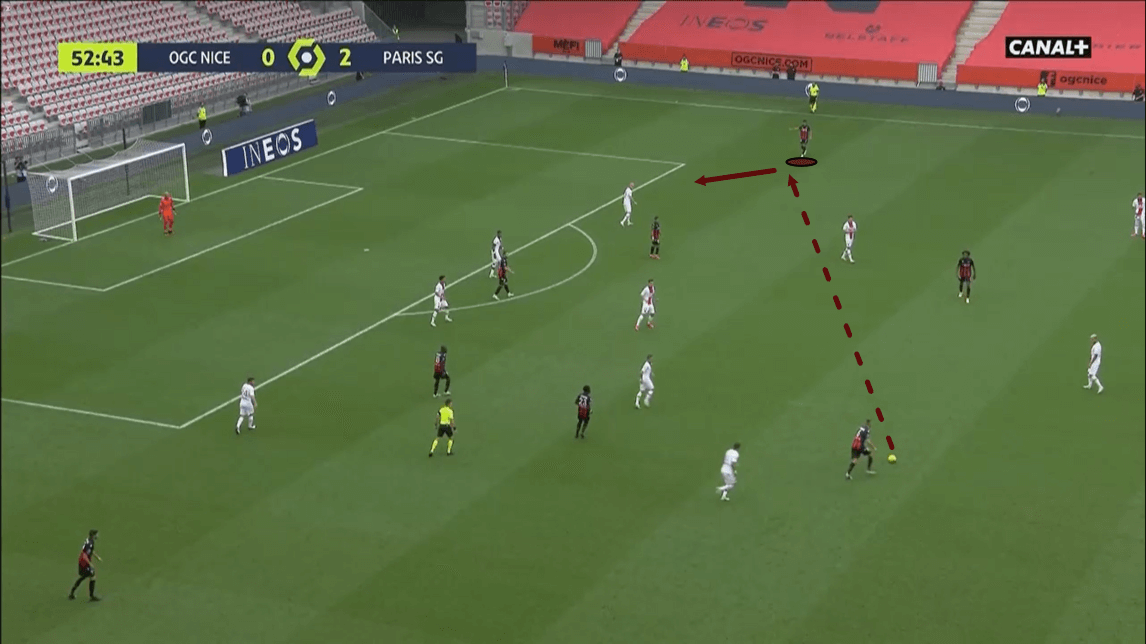
Lastly, Nice liked to make quick switches of play from one wing to the other inside of the final third in this game and we can see one example of this in action in the image above.
Les Aiglons liked to play around with the ball, utilising short passes on one side of the pitch, attracting the PSG defence to that side of the pitch in the process and after doing that, they would quickly switch the play over to the opposite wing.
They usually did this playing from the left-wing to the right-wing, finding the overlapping Atal, in this game, as they tried to get Atal on the ball one-on-one against Bakker. Atal had plenty of chances to exhibit his dribbling ability as a result, engaging in seven offensive duels during the game and winning three of them.
So, it’s clear that despite failing to create many clear-cut chances in this game, Nice did deploy some successful and interesting offensive tactics that caused Paris some problems.
Nice out of possession
Lastly, we’re going to look at the tactics that Vieira’s side deployed off the ball in this game. As per Wyscout, Nice’s average formation line (45.4m) was lower than Paris’ (62.3m) during this game. This indicates that Nice generally sat in a deeper block than Paris did in this game, with PSG pressing high up the pitch and Nice going for a somewhat more reserved approach.
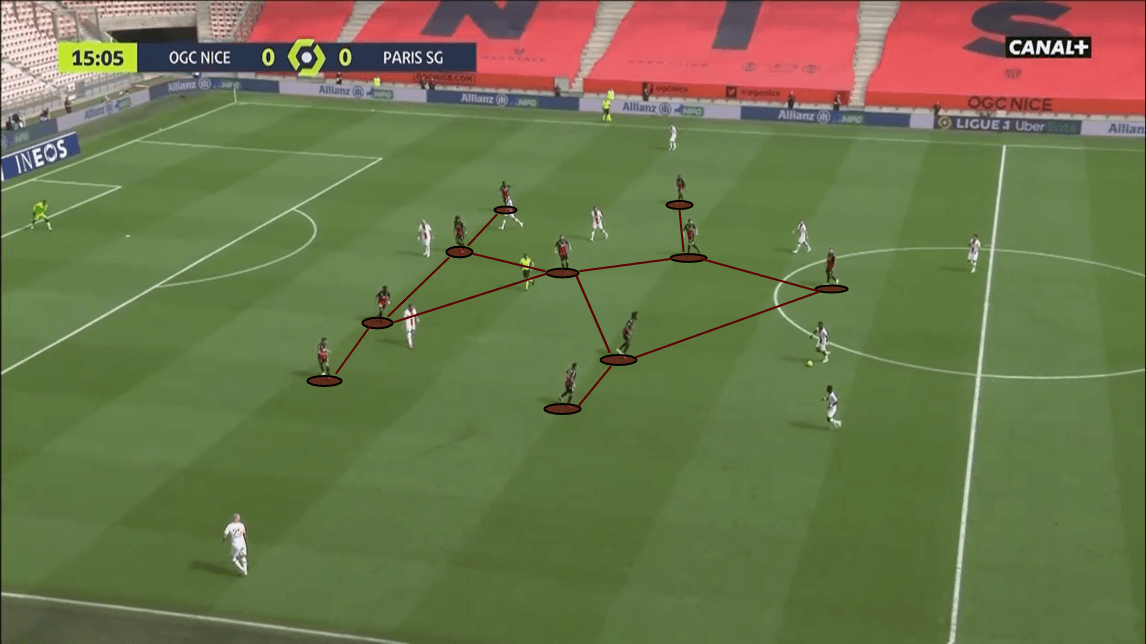
The image above shows us an example of Nice’s typical defensive shape in Sunday’s clash with PSG and as we can see, it’s essentially a narrow, compact, 4-1-4-1 mid-block. This formation gave up plenty of space on the wings and we’ve already discussed how PSG capitalised on this during this past weekend’s game, however, the shape was successful at preventing Paris from playing through the lines and blocked off the more straight forward, central path to the goal, as we can see.
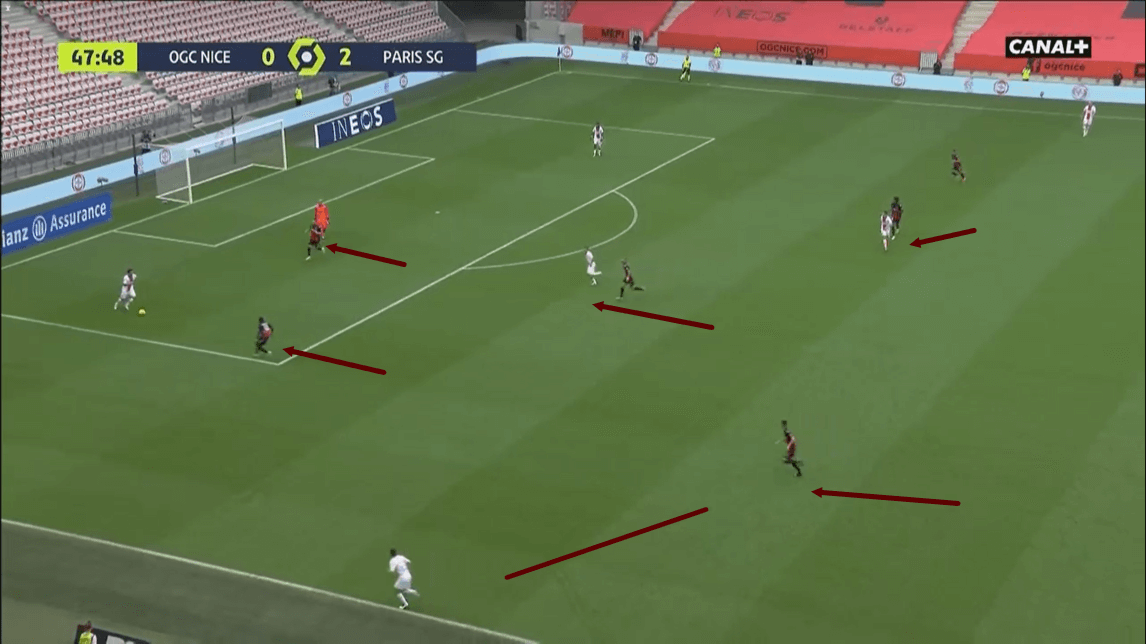
However, on some occasions, especially in the second half when trailing by two/three goals, Nice did press higher. On some occasions when Paris played the ball backwards as a result of struggling to play through Nice’s block, they then attracted a more aggressive press from Nice when playing the ball backwards.
We can see an example of this press in action in the image above and it seems as though Les Aiglons would have liked Paris’ right centre-back, Marquinhos, to have played the ball out to the right-back here, with the other near short passing options being marked tightly, however, Marquinhos avoids this pass, with one Nice player maintaining access to the PSG full-back and instead, he manages to play past the press via an accurate long-ball, so, while Nice deployed a fairly effective high press on occasion, it’s clear that the quality of PSG’s defenders on the ball allowed them to deal with the pressure and play past it without too much trouble.
So, while Nice’s defensive tactics had some positives and caused Nice some problems, PSG were capable of finding the answers to those problems and that quality they showed is why they came away with a 3-0 win.
Conclusion
To conclude this tactical analysis piece, it may be fair to say that both teams displayed some interesting tactical ideas both in and out of possession during this game but PSG’s quality prevailed, as they ultimately had the answers to all of the questions that Nice asked of them on Sunday, while Nice struggled to penetrate Les Parisiens’ backline despite showing some impressive ability early on in the attacking stage of play throughout this game.





Comments